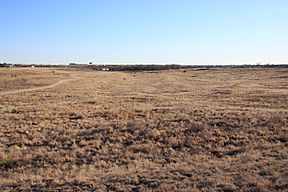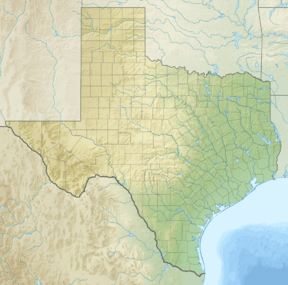Yellow House Draw facts for kids
Quick facts for kids Yellow House Draw |
|
|---|---|

Yellow House Draw – a dry remnant of a wetter past
|
|
| Length | 130 kilometres (81 mi) |
| Area | 9,790 square kilometres (3,780 sq mi) |
| Geography | |
Yellow House Draw is a stream that is usually dry. It's about 236 kilometers (147 miles) long. It starts near Melrose, New Mexico, and flows mostly southeast. This stream crosses a large flat area called the Llano Estacado.
When it reaches the city of Lubbock, it joins another stream called Blackwater Draw. Together, they form Yellow House Canyon. This canyon then becomes the start of the North Fork Double Mountain Fork Brazos River. Yellow House Draw flows through parts of New Mexico and West Texas. It helps drain water from a huge area, about 9,790 square kilometers (3,780 square miles).
Lubbock Lake Landmark
The Lubbock Lake Landmark is a very important place. It's an archeological site and a natural history preserve. This means it's a place where scientists study old human history and protect nature. It's located in a bend of Yellow House Draw in Lubbock, Texas.
Long ago, Native Americans and early settlers used the natural springs here for water. But in the early 1930s, these springs dried up. This happened because too much water was being pumped from the Ogallala Aquifer. An aquifer is a large underground layer of rock that holds water.
In 1936, the city of Lubbock tried to dig out the stream bend to create a lake for water. This didn't work for water supply. However, their digging uncovered amazing ancient artifacts. These finds showed how important the site was for understanding history. Today, there isn't much standing water left, and no actual lake. But the site is a famous archeological landmark.
Canyon Lakes
Inside Lubbock city limits, there's a cool system of lakes called the Jim Bertram Canyon Lakes System. The city's parks department built these narrow lakes. They are partly in Yellow House Draw and partly in Yellow House Canyon.
There are six lakes in this system, from northwest to southeast: Conquistador Lake, Llano Estacado Lake, Comancheria Lake, Vaquero Lake, Canyon Lake, and Dunbar Historical Lake. Vaquero Lake and Canyon Lake are inside Mackenzie Park. At Vaquero Lake, Blackwater Draw and Yellow House Draw meet.
These Canyon Lakes are great for enjoying nature and having fun. They also play a key role in Lubbock's water system. The city cleans its wastewater and then uses it to water crops at a special farm. This farm is called the Lubbock Land Application Site. It's a huge area, about 6,000 acres (24 square kilometers).
At this site, treated water is sprayed onto crops. The soil and dirt act like a natural filter, cleaning the water even more. To protect the Ogallala Aquifer, the clean water is then pumped from under the farm. This water goes to the Canyon Lakes. From there, the water flows from one lake to the next. Eventually, it flows into Yellow House Canyon, forming the North Fork Double Mountain Fork Brazos River.


